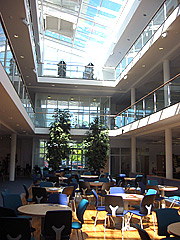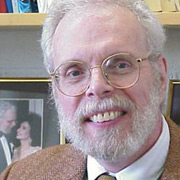Hold the AC
Operating commercial buildings consumes a sixth of all the energy used in the western world. Getting rid of air conditioning could cut that consumption by as much as a third—but people can’t work in sweltering heat.
Researchers at MIT are making computer-based tools that will help architects design commercial buildings that cool their occupants using natural breezes.
“That approach improves air quality, ensures good ventilation, and saves both energy and money,” said Professor Leon R. Glicksman, director of MIT’s Building Technology Program. Indeed, studies have shown that people generally feel more comfortable in a naturally ventilated building than in an air-conditioned one.
Yet few commercial buildings now use natural ventilation. “The approach is new, and architects worry it won’t work in the buildings they’re designing,” said Glicksman. He and his collaborators at MIT and Cambridge University in England are developing new computer tools and scale-model experiments that will help to alleviate those worries.
Their studies focus on an office building in Luton, England, that was designed for natural ventilation. The building features multiple floors opening onto a large central atrium, operable windows on each floor, and five large vents at the top of the atrium with fans that provide added ventilation when necessary.
For six months, the research teams monitored temperatures and other conditions throughout the building. For the most part, the building behaved as expected: fresh air came in through the windows, entered the atrium, rose, and exited through the ceiling vents. But measurements on some floors near the atrium opening showed air moving toward the side windows instead of away from them.
So the researchers brought other tools to bear. They did carefully controlled experiments using a one-twelfth-size replica of the Luton building, equipped with heating elements to represent people, computers, and so on. And they created computer simulations that—based on incoming winds, indoor heat sources, and other factors—can calculate airflows between rooms, the atrium, and outside as well as conditions within single rooms.
Their findings explained the unexpected measurements in the full-scale building. Because of temperature differences and buoyancy effects, cooler air can at times slip over a partition at the edge of the atrium and enter an office, moving along the floor and then quickly rising and heading out along the ceiling—a local reverse eddy.
“We found what we initially thought were some strange results when we did the full-scale-building tests,” said Professor Glicksman. “But using the computer model, we now understand the physics of it, first of all confirming that it’s a real effect and second, why it occurred.” Such effects can be corrected by building in automatic control systems that, for example, turn on the vent fans just when needed to ensure the continuous flow of fresh air.
Based on their findings, the MIT team is formulating a simple, user-friendly computer tool that will help architects design for natural ventilation. They plan to incorporate the tool into their “Design Advisor,” a website that lets architects and planners see how building orientation, window technology, and other design choices will affect energy use and occupant comfort.
Glicksman hopes that the new tool and better understanding will help overcome the biggest challenge to natural ventilation—convincing architects and building operators that it will work and showing them how well it will work for proposed new designs.



